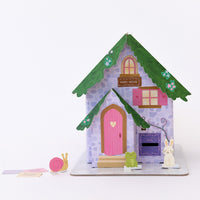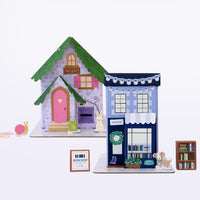
By now we are all aware that our actions have an impact on the world around us. What we do as individuals or families has a ripple effect on our communities and, more broadly, the health of our planet. Sustainable shopping, or making informed and intentional decisions about purchases to ensure what you’re buying is made without exploiting the planet, is one-way individuals and families can make a big difference in the overall health of our planet. Children are never too young to be exposed to conversations about making sustainable shopping choices for their families. The more they overhear these conversations from a young age, the more primed they will be to be aware of their impact on the planet and eventually, be active participants in meaningful conversations about sustainable shopping and help make environmentally friendly choices when considering making purchases.
Engaging children in eco-friendly shopping can have many benefits. Kids will be more aware of the Earth and its resources and will likely choose to actively engage in making changes to their habits to help protect the Earth. Many children actively take a role in ensuring their families do not waste water once they learn that water is not always readily available for people and should not be run unnecessarily. After children are directly taught to turn off water while actively brushing their teeth, for example, this becomes a habit for them. This same concept can be applied when discussing family purchases: children can be empowered by giving them information and agency.
Why Sustainable Shopping Matters
Consumer choices have a direct effect on the environment. Whether it is deciding whether to purchase used or new items (including clothing) or choosing to pick products based on the materials they’re made from, those decisions matter and have consequences for the greater good of society. While that may seem overstated, it is not. According to EARTHDAY.ORG, these choices, especially in the fashion industry, have major consequences Each purchase has a ripple effect impact. If you actively choose to make fewer purchases, you are making sure that fewer items eventually end up in landfills, for example. Selecting items made from recycled materials over brand new ones ensures less chemicals are being emitted which affects the health of not only the Earth but people as well. By supporting sustainable shopping practices, including buying less, choosing items made from recycled materials, and looking to support companies that use renewable energy (such as solar power) to make their products, individuals can make a large difference in reducing their environmental footprints.
As a general rule, parents and caregivers are making financial choices in their households, including what products are being purchased. However, they can have a large impact on their children’s attitudes towards sustainability by directly teaching and actively modeling their thinking around choosing eco-friendly products for their home and family. Children can then carry that knowledge into future conversations about sustainability and their roles in protecting the planet, and, eventually, into their choices when making purchases. In addition to thinking of children’s future roles in sustainability, thought leaders, such as Carlie D. Trott and Andrea E. Weinberg of the University of Cincinnati and Arizona State University respectively, argue that children can be a driving force for societal change regarding sustainability now, if we choose to include them in science concepts today.
Benefits of Involving Children
There are numerous benefits of involving children in sustainable shopping. It can foster a sense of awareness and responsibility in children, educate them in a hands-on way, and strengthen family bonds through shared values and experiences. When children are given opportunities to pitch in, they step up to the plate in a big way. As caregivers, we can empower children to take responsibility for their actions and how they affect the world around them.
Tips for Engaging Kids In Eco-Conscious Shopping
Introducing kids to sustainable shopping starts by deciding how to frame environmental awareness with them. As caregivers, we want to share enough information to educate and empower them but remember to keep it age-appropriate.
For younger children, actions speak louder than words. We can actively make choices in our homes that support our belief system regarding protecting the environment and while we do so, we can take extra care to ensure our children are aware we are doing so. One way to do this is to teach through example by checking the labels at the store or thoroughly researching online to decide whether to purchase a product, such as a new toy or piece of clothing, to ensure that it was made in an eco-conscious manner. We love brands like Manymoons, who guarantee that their products are “always natural, sustainable and ethically made” so there is no doubt when shopping with them that you’re making a choice that is good for the environment.
Another easy way to draw children’s attention to the choices that you’re making is to ask them questions. For example, you can ask “Which do you think is better: shopping at a store that sells all brand-new items or going to a store where you can buy things that can be reused again?” This could get your child thinking about the bigger picture and lead to a discussion about reducing items that end up in a landfill. Once kids are aware of a problem and understand that their actions can make a difference, they’re sure to share their opinions when discussing choosing eco-friendly products for their home.
As your kids get slightly older, you can introduce them to the various labels, certifications, and eco-friendly brands that exist in the market. Explaining to them that items are made in various ways, some better for the planet than others, and encouraging them to be aware and actively look for reputable brands in the eco-friendly sphere helps them build awareness and knowledge around the concept of sustainable shopping.
Integrate eco-friendly concepts into your everyday life with your children, including encouraging eco-friendly crafts, including upcycling. Integrating sustainability practices into your child’s lives helps them understand the importance of them and realize that these types of decisions don’t just affect shopping and purchasing decisions, but weave into their lives daily.
You may hit some roadblocks along the way, such as the cost or limited availability of sustainable products in the market but there are often budget-friendly eco-shopping alternatives.
Sustainability in Action
We at Make It Cute are huge proponents of choosing sustainable products for our own families whenever possible, which is why it was so important to us to make sure that our playhouses are not only built with sustainable materials but are one hundred percent recyclable on the back end of use.
As founders, we made a conscious decision to embrace sustainability as one of our core values which is why we also plant a tree in partnership with EARTHDAY.ORG’s The Canopy Project for each playhouse sold. We chose sustainable materials to create a product that our customers could feel good about putting in their homes. As mothers ourselves, we know how much plastic can accumulate in our homes while raising young children. Between their utensils and the ever-changing trendy toys that are constantly being marketed to us, the options for adding plastic to our homes are endless. We decided early on that we would stick close to our beliefs and make sustainable products that we could stand behind and feel proud to put out into the world, knowing that we weren’t hurting the Earth in the process.
We’ve had wonderful feedback about our indoor playhouses from customers who are also big fans of reducing the plastic in their homes. We are particularly thrilled when we hear from customers who not only think our playhouses are cute but believe in what we are trying to accomplish from a sustainability standpoint. Kathy S. shared a review about her two-year-old daughter, Maggie, saying “It’s a great addition and we are delighted we haven’t added even more plastic to our home.”
The benefits of involving children in sustainable shopping are huge. They become aware of the bigger picture of the world around them and can make a marked difference in the world with the choices that they’ll help make now and eventually make themselves in the future. Creating awareness around eco-conscious choices in your lifestyle now will build shared values as your children grow and build their confidence in their ability to make smart sustainable choices in the future. Individual choices as well as collective action in creating a sustainable future need to begin now. While we may worry that our children are too young to understand, there is never a time that is too early to begin exposing them to the concepts of sustainability.
Join Make It Cute in making choices that will benefit the health of our families and our planet by choosing to invest in sustainability today!
Connect with us on Instagram @makeitcutekids to learn more about what we’re doing to help the environment!









